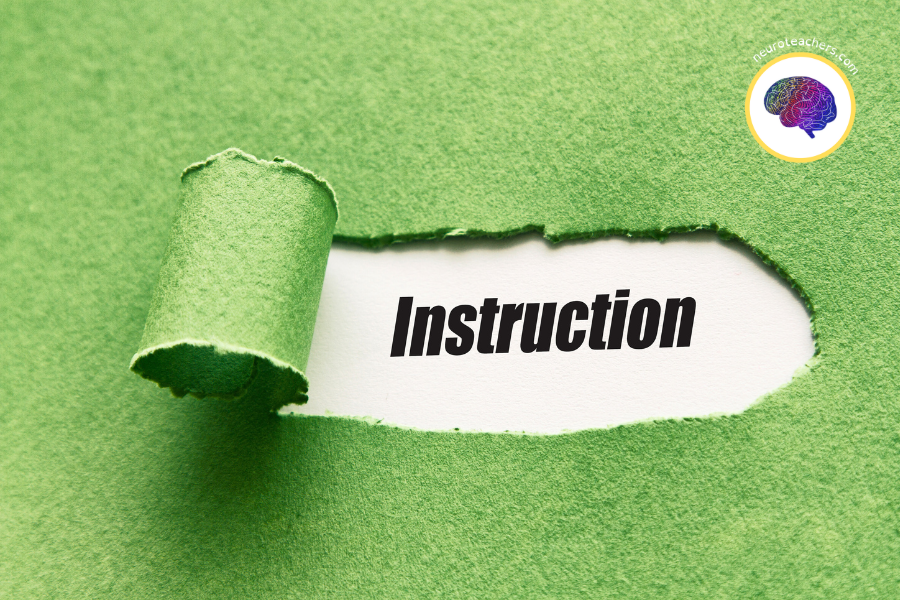The importance of giving clear instructions
Have you ever made a really big mistake that you knew was your fault? I think I have made countless errors in my teaching career, but few stick in my memory so clearly as the time Colin, a year 8 student with autism and global delay, wrote the F word 6 times on a worksheet I had carefully made for him.
Now, on the face of it, what Colin did was very wrong. Swearing is a serious misdemeanour, however you look at it and he really shouldn’t have done that, yet I had only myself to blame for his actions. And here is why; I hadn’t given clear enough instructions.
Giving clear instructions is a skill. Arguably it’s up there with differentiation and classroom management as one of the most important things you need to be able to do in order to run an effective classroom. Up until that fateful day with Colin, I really believed I had it down to a tea. Though clearly, I was wrong.

This all happened when I was a modern languages teacher. I taught Colin, who had a statement ( the for runner to an EHCP) for French. He was part of a very difficult class of year eight students https://neuroteachers.com/post/a-controversial-blog-about-behaviour-part-2/
For my afternoon lessons Colin had no support ,which meant that he initially spent most of the lesson rolling around on the floor or hiding under the desk but after several weeks of hard effort upon both of our parts, he was ready to sit at the table and give enough attention to be able to do some work.
Honestly, French meant nothing to him. Much as I love the language, I could see that there were so many other gaps in his education that needed to be taught, it was very difficult to see the purpose of what I was doing. Nevertheless, I persisted.
I was conscious that he had targets on his statement I really wanted to incorporate these into the lesson, so I devised what I thought was a fool proof method to make sure that he was able to follow what I’d asked him to do. I felt proud of myself being able to get to the stage with him. I was now certain I could do the next step ,which was to teach Colin follow my instructions and copy from the board. Now at the time I hadn’t occurred to me that this was two targets; to follow my instructions being the first one and copy from the board being the second one.But I was young and relatively inexperienced at this stage, and I didn’t have any real knowledge of either of the conditions that Colin was diagnosed with. I only did what I thought was right with a child in front of me.
On the afternoon in question the lesson was about food. The exercise that I had given the class was to copy pictures of various fruit and label them in French. To make this task as easy as possible I gave Colin a small work sheet with the pictures drawn upon them and lines underneath indicating where he should write. And then carefully told Colin “Copy the word underneath the pictures.

I then gave Colin a pen and pointed to the worksheet. To my great surprise his head went down immediately, and he sat looking as if he was completing the work perfectly. With a sense of pride, I walked over to a different part of the room to help another student.
When I returned Colin was all smiles. He looked up at his pen down and said’ Finished miss!’ I got out my marking pen and had a look at the sheet. Colin had indeed written a word underneath each picture of the piece of fruit. However, the word that he had written
started with an F, and had four capital letters in it, and certainly wasn’t what I had written on the board. At this point it became instantly obvious but my mistake of being.
“Colin which word are you copying?”
“This one miss.” And he pointed to a word which had been carved into the table he was sitting at in large letters. It was a word, but not the one and ask them to copy.
“Colin, I wanted you to copy these words. Not the one on the table. Never mind we can have another go next lesson.” And I found him something else to do.
Copying is not an easy task. It requires fine and gross motor skills and hand eye coordination, which is beyond many children’s capability, and should not be underestimated of the skill.
Giving instructions is also difficult. What I probably should’ve said to Colin was “Colin, I want you to copy the words underneath these pictures onto your worksheet.” This should have been accompanied by me pointing to the words on the board and the gap on the worksheet. I then should have done one or two examples with Colin. But I guess this was a lesson that I had to learn from myself and ever since I met Colin I always double check understanding before leaving my student to do an exercise and supervised, especially if they are as vulnerable as Colin was.
